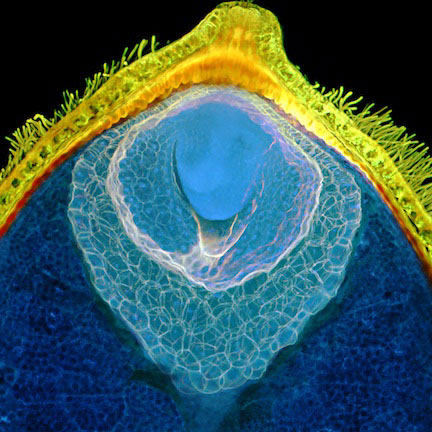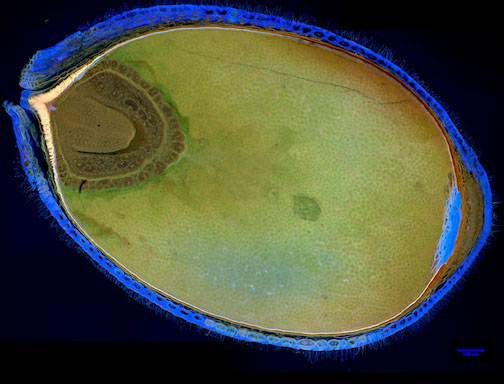Mystery of Flowers Unveiled: Reproduction to Parenting
William (Ned) Friedman, Arnold Professor of Organismic and Evolutionary Biology and Director of The Arnold Arboretum of Harvard University
Flowers play a central role in the reproductive cycle of plants. Their colors, shape, fragrance, and nectar are all designed to attract insects and other pollinators to carry the genetic material from flower to flower. While flowering plants are the largest group of land plants and the type of plants most familiar to us, they still hold much mystery as to how they evolved. Recent research findings shed light on some of these ancient flowering plants.
For 30 years, William (Ned) Friedman has been investigating a longstanding set of questions about the origin and early evolutionary history of flowering plants, Darwin’s so-called “abominable mystery.” His research has involved plant species native to the Namib and Sonoran deserts; rainforests of Queensland, New Caledonia; and most recently equatorial Africa. Many of the plants that form the foundation of this research program have been ex situ specimens in botanical gardens and university greenhouse collections. Indeed, some of the key taxa central to reconstructing the evolutionary history of plants can only be studied in garden and greenhouse collections because they are extinct in the wild.
Research from Friedman’s lab that was announced last week in the Proceedings of the Royal Society B uses just such a species, Nymphaea thermarum, a water lily from equatorial Africa. Sadly, as a consequence of habitat degradation, this beautiful water lily lives on only in botanical gardens or research greenhouses.
Reproductive Biology of Nymphaea thermarum
Flowers of Nymphaea thermarum are hermaphroditic. The flowers open and close over the course of several days. However, unlike most other water lilies where male and female functions occur on different days, in N. thermarum pollen release overlaps with the female phase, marked with the secretion of a prominent drop of fluid that covers the receptive stigmatic surface. Indications are that N. thermarum is predisposed towards self-pollination.
This process is important for the evolution and cultivation of this species:
- N. thermarum can self-fertilize. This may mean that remaining populations have little genetic diversity.
- Flowers can be emasculated by removing the anthers at least 24 hours before the bud first opens.
What happens after reproduction is also important to the story of N. thermarum. Rebecca Povilus (recent doctoral student, Harvard University), Pamela Diggle (professor, University of Connecticut), and Friedman, took advantage of the uniquely brief life cycle of N. thermarum to investigate the theory of inter-parental conflict in plants.
Parenting
Disagreements between mothers and fathers about how best to rear progeny is not restricted to humans—the battle of the sexes extends to plants too. In their paper “Evidence for parent-of-origin effects and interparental conflict in seeds of an ancient flowering plant lineage,” Povilus, Diggle, and Friedman demonstrate that in a member of one of the oldest flowering plant lineages still in existence, mothers (seed-bearing plants) and fathers (pollen-producing plants) each try to outsmart each other and distribute maternal resources to progeny in order to maximize their own fitness. Fathers display selfish behavior and attempt to drive maternal resources to their own progeny, while mothers take a more balanced view of what is universally best for all of her offspring.
This is the second piece of recent research from the Friedman lab to study an extinct-in-the-wild species. Working with another graduate student, Kristel Schoonderwoerd, the unusual reproductive biology of Franklinia alatamaha (Franklin tree) was analyzed for the first time and published in the Botanical Journal of the Linnean Society. If not for the efforts of William Bartram, who collected Franklinia seed in the late 1700s and introduced this species into gardens in Europe and North America, this extraordinarily beautiful late summer and fall flowering member of the tea family (Theaceae) would be unknown to us, having last been seen in the wild in 1803. All of this is a stark reminder that the conservation efforts of botanical gardens around the world are not only critical to preserving biodiversity, but also to unlocking the secrets of plants and their unique evolutionary history.


Photos of the inside of the seeds (taken with a confocal microscope). They both show the inside of mature or nearly-mature seeds – one shows the whole seed, one is a close-up of part of the seed. For scale, the seeds are about 1-2 millimeters long. The pictures show the major tissue types within a water lily seed: an embryo, it’s sibling tissue (‘endosperm’), a nutrient-storage tissue derived from the mother, and a fuzzy, hair-covered seed coat. (Photos @Rebecca Povilus)
Content provided by William (Ned) Friedman
(Reproductive Biology of Nymphaea thermarum taken from https://nthermarum.weebly.com/reproductive-biology.html, a website created and maintained by Rebecca Povilus)
For further reading:
“Floral biology and ovule and seed ontogeny of Nymphaea thermarum, a water lily at the brink of extinction with potential as a model system for basal angiosperms.” Rebecca A. Povilus Juan M. Losada William E. Friedman. Annals of Botany, Volume 115, Issue 2, 1 February 2015, Pages 211–226.
“Evidence for parent-of-origin effects and interparental conflict in seeds of an ancient flowering plant lineage,” Rebecca A. Povilus, Pamela K. Diggle, William E. Friedman. Proceedings of the Royal Society B, volume 285, issue 1872, 7 February 2018.